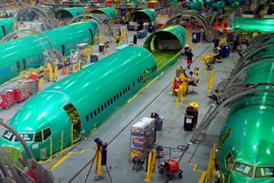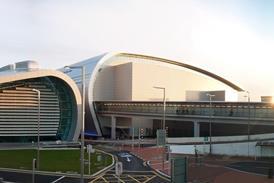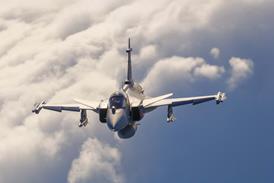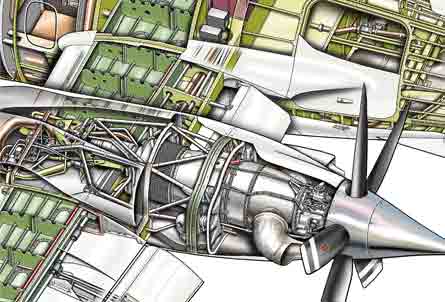Piaggio survived bankruptcy after investing heavily in its P180 Avanti. Now its faith in the visionary pusher turboprop business aircraft looks set to pay off
When the Piaggio Avanti was first presented to the public in the mid-1980s, the three-lifting-surface pusher-turboprop design was considered revolutionary, with only the all-composite Beech Starship presenting the business aircraft market with a similar configuration.
The Starship is now long gone, but the Avanti II, with more power, increased maximum take-off weight and a genuine 400kt (740km/h) cruising speed, is selling so well that Piaggio is increasing production to keep up with sales.
|
|---|
The five bladed Hartzell propellers spin in clean air and avoid compromising the airflow over the wing |
The story of the original Avanti ended in the 1990s when the far-sighted vision and determination of company owner Rinaldo Piaggio bankrupted the Genoa-based company after it had invested huge amounts in design and testing - only to run out of money for production and after-sales support. Then, in 1998, the company was rescued by a consortium headed by Josè Di Mase and Piero Ferrari, bringing not only badly needed money for investment in new facilities, but a world-renowned brand logo, which is now seen on the Avanti II that flies the Ferrari Formula One motor-racing team around the world.
Ferrari became chairman and Di Mase chief executive. They lead a company that, uniquely, manufactures not just aircraft but aeroengines, holding partnerships with Rolls-Royce Turbomeca and Pratt & Whitney on the RTM322 helicopter and F135 Joint Strike Fighter engines respectively. In October 2006 a deal was signed with Pratt & Whitney Canada to manufacture PW206/207 helicopter engines.
The Avanti was conceived in 1979, after the first global oil crisis had sent fuel prices skyrocketing and led many in the aerospace industry to rethink their approach to engine and airframe design. In the field of business aircraft, Piaggio and Beechcraft both came up with configurations aimed at combining the fuel economy of a turboprop with the performance of a jet. While Beechcraft went with a canard configuration to reduce drag, the Avanti was provided with a foreplane to provide stability. On a conventional two-surface aircraft, stability is provided by a downforce on the rear horizontal stabiliser, but on the Avanti it becomes a lifting surface, which means the wing can be smaller, reducing induced drag and fuel burn.
The wing and fuselage were designed to have laminar flow over 50% and 10% of their respective surfaces, reducing overall drag by around 5%. The wing is positioned behind the fuselage pressure bulkhead - possible because of the foreplane - enabling the Avanti to have a larger passenger cabin than its contemporaries. Another advantage of the aft wing position was that the main landing gear can be stowed behind the pressure bulkhead, simplifying the design.
A pair of wing-mounted, rear-facing P&WC PT6A-66 turboprops were arranged in a configuration that had, for different reasons, been seen on Piaggio's earlier P136 and P166 amphibians. For the high-speed Avanti, the advantage of the pusher layout was that the five-bladed Hartzell propellers would not compromise the laminar airflow over the wing.
The original Avanti I (as it is now called) was certificated in 1990 and went into limited production - only 28 were built and delivered before the bankruptcy. The remaining 76 Avanti Is now in service were built by the new Piaggio Aero Industries. So far 125 P180s, including 25 Avanti IIs, have been delivered and are in service.
The Avanti I met - or nearly met - its performance goals, which were considered extraordinary even then: to offer a business turboprop capable of a 400kt maximum cruise, 39,700ft (12,100m) cruising altitude and a range of at least 2,000km (1,100nm). The aircraft was also to have take-off and landing performance the same as or better than turbofan-powered business jets.
The P180 took to the air in September 1986 and proved capable of 382kt at 30,000ft - just 18kt slower than the 400kt target - and achieved a maximum dive speed of Mach 0.771, corresponding to 465kt. Piaggio had designed and built the fastest turboprop in its category.
Bankruptcy ended the dream, however, and the project slowed to a crawl while the new owners took stock and began the process of reorganising one of the world's oldest aircraft companies. This led to the decision to completely re-evaluate the Avanti in terms not only of performance but of producibility and support.

Intensive studies
Technical director Antonio Maglione joined the restructured Piaggio Aero Industries in 2001, and remembers that the company was using "more of a craftsman's approach" to building the aircraft than modern, efficient industrial processes and technologies. "We had basically an excellent design," he says. "So between 2002 and 2004 we carried out a series of intensive studies, and decided we could do several things to improve it, but without changing the excellent virtues of the original Avanti."
Three main changes were imposed on the original design to create the Avanti II: a 5% increase in maximum take-off weight (MTOW), a true cruising speed of 400kt at 30,000ft and a new integrated avionics suite. Maglione says that succeeding with the changes required not just Piaggio's own engineers, but "excellent co-operation" from the three principal suppliers: Messier-Dowty, P&WC and Rockwell Collins.
To enable the weight increase, Messier-Dowty had to find extra performance in the landing gear without an expensive, time-consuming redesign, while P&WC produced extra power from its PT6A-66A without compromising margins and Rockwell Collins had to install its Pro-Line 21 integrated cockpit in the existing airframe.
"We managed to achieve the extra MTOW without any physical change to the aircraft," says Maglione. "Messier-Dowty did a lot of tests and extrapolation studies and found that all they had to do was increase tyre and oleo leg pressures to give the landing gear the required performance." The result is an increase of 250kg (550lb), bringing the Avanti II MTOW to 5,489kg.
Piaggio also re-evaluated the average use of the Avanti fleet and found that the original basic mission loads had been too conservative, so that the MTOW increase could be obtained with no reduction in airframe fatigue life. Trials on a test wing that had reached the end of its fatigue life enabled the company to find the ultimate static load and increase the maximum zero fuel weight by 130kg, to 4,445kg. "We reached 159% of the limit load with no damage," says Maglione.
The increased engine performance was obtained by P&WC with a new compressor and hot-section materials. The resulting 1,630shp (1,210kW) PT6A-66B produces 8-13% more power in cruise and climb, but remains flat-rated to 850shp. "Keeping the original flat rating avoided the expensive, time-consuming certification programme that would have been necessary if we had changed the take-off performance," says Piaggio business development manager Fabio Sciacca. "The take-off is pretty good already, but pilots will appreciate the extra power in climb and cruise. It enables them to keep pace with other aircraft at higher levels."
The Avanti II is capable of flying at Mach 0.70/402kt at 30,000ft and has a maximum altitude of 41,000ft, which is the highest flight level for any member of the ubiquitous PT6 family. "Pratt & Whitney Canada did a fantastic job of retaining engine performance margins with the more aggressive compressor design," says Maglione.
The third major change brought in the completely new Pro Line 21 digital avionics system from Rockwell Collins, which includes three 10 x 8in (255 x 200mm) liquid-crystal displays, two display control panels, a single cursor control panel and integrated avionics processor. "This isn't just a facelift," says Maglione. "It's a total nose-to-tail redesign of the avionics."
Other features include the company's FMS-3000 flight management system and AHS-3000 attitude heading reference system. The basic communication system includes one VHF-4000 communication transceiver, two TDR-94D Mode-S diversity transponders, one DME-4000 transceiver, one NAV-4000 VOR/ILS/ADF receiver and a NAV-4500 VOR/ILS receiver. The new avionics, besides giving pilots better situational awareness, saves 59kg, uses less power and has far less wiring.
The improvements have had a dramatic effect on sales. According to Sciacca, the Avanti II is sold out for 2007 with only three positions left for 2008, "and two of those are about to go". With 14 positions taken, 2009 is already looking good.
Much of the Avanti's success to date has come from the USA, where 73 of the 126 aircraft now flying are based, most owned by Avantair, the Avanti fractional ownership provider, which ordered 36 more aircraft at the 2005 NBAA show.
Prospects for the Avanti II have been further improved by the arrival in early 2006 of Abu Dhabi investment group Mubadala Development, which took a 35% stake in Paiggio. Besides providing extra cash to invest in the Avanti, and a possible all-new turbofan-powered business jet, the move is certain to improve sales prospects for the Avanti II in the Middle East. "We couldn't ask for a better partner," says Di Mase. He stresses, however, that new markets will have to wait until the production system has been upgraded.
Manufacturing changes
One of the greatest challenges facing Piaggio is to increase the rate at which the Avanti is manufactured, the original aircraft having been built using largely traditional methods based on two-dimensional computer-aided design techniques.
Di Mase says there is a "total commitment" to increasing the rate of production. "We have a very big opportunity...but we don't want to go into new markets yet. If I could build 45 aircraft this year and next we'd be sold out for two years, but we're not there yet, so we're having to manage the orderbook," he adds.
A huge effort has been expended on creating a full three-dimensional design environment using Dassault Systemes' Catia, around which the modernisation of the production process can take place. Final assembly of the Avanti is carried out at Genoa, with parts production and subassembly at the 100-year-old plant at Finale Ligure, 70km (45 miles) away. Work is due to begin this year on a new greenfield facility at Villanova d'Albenga, which will use the latest lean manufacturing techniques - some of which have already been already introduced at Genoa.
Extra capacity has been created at Genoa by ending various unprofitable subcontracts, including wings for Alenia's C-27J military transport. "We need to focus entirely on Avanti production," says Matteo Cecada, Avanti II assembly line manager. "We're also looking at outsourcing, probably to east Europe, so that we can concentrate more on the high technology aspects of manufacture."
Final assembly will remain at Genoa, but is being reorganised. Currently, assembly takes place at eight stations, at each of which a combination of three activities takes place - electrical, mechanical, and interior fitting. The aircraft spends nine days on each station, so that final assembly of each takes 72 days.
In 2008, the number of stations will be increased to 11, but the number of days at each will be reduced to six, bringing overall assembly time down to 66 days. The mix of activities at each station will be altered to improve production efficiency and will open the way for further potential assembly time reductions in future.
The unique "inside out" procedure for assembling the highly curved fuselage skins of the Avanti will continue to be used, and although time-consuming is considered worthwhile because of the result - a highly efficient aerodynamic shape. Fuselage production uses special tooling manufactured by Piaggio, which holds the fuselage skins to the curved jigs using a vacuum. The window openings are then cut from the inside, and the fuselage stringers attached.
Wing panels
Cecada says the wing panels, uniquely, comprise just four main components machined from solid aluminium - the upper and lower skins and fore and aft longerons. This means rivets are used only to attach the longerons, reducing drag.
While keeping the basic process of assembly intact, Piaggio has managed to reduce the parts count in the aircraft by 600, and the number of fasteners by 5,000, mainly by using high-speed numerically controlled machining.
Overall, Maglione says the changes developed for the Avanti II have involved 220,000 engineering hours, one full-scale wing test and many subcomponent tests on primary structures, as well as increased use of predictive dynamic modelling - unavailable when the original aircraft was designed - to squeeze more capability out of the existing structure.
With production rates rising and sales increasing, the distinctive shape of the Avanti looks set to become a permanent fixture in the line-up of business aircraft. And Di Mase believes that, as fuel prices continue to increase, the benefits of efficient turboprop propulsion may drive Avanti sales even faster. "We're improving day by day," he says. "And we're having fun doing it."
Business aviation page....
Business aviation pocket guide...
Source: Flight International

























